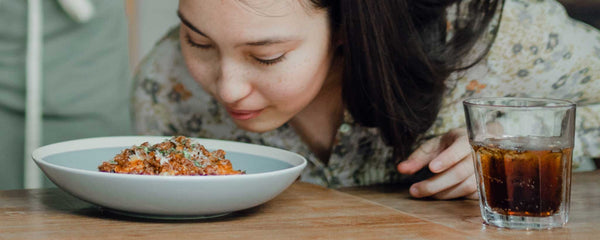Diners want you, as the chef, to taste food before serving. But there is a fine line between sanitary tasting and pre-eating meals.
Taste Wisely
It is embarrassing to serve food and realize that it lacks adequate seasoning. Achieving optimum flavor is progressive. Sautéing onions, softening dry herbs, and roasting vegetables are time-sensitive steps. Culinary classes emphasize layering flavors, or seasoning every component as you build a dish.
To the extent possible, it is wise to taste during preparation. Make certain you do not cross the line between tasting and pre-eating. No grown person wants you to serve them a plate of food after you’ve dined in it.
The Art of Tasting
1. Avoid cross-contamination. Do not use the same utensil for butchering raw meat as you do for slicing cooked food. In this regard, taste with clean utensils.
2. Wash your hands frequently. It is counterproductive to use a clean spoon for tasting while your hand is dripping raw eggs.
3. Don’t guzzle. Beer, wine, sherry, bourbon, and other alcohols are sometimes part of a recipe. Avoid any temptation to drink straight from the bottle before pouring it onto the food. Use a separate glass for tasting.
4. No double-dipping. Stirring a pot and lifting the spoon to taste before submerging again is unsanitary. Either use a fresh spoon for tasting or wash off the one for stirring.
5. Don’t hover. A key distinction between dining and tasting is hovering over the meal while scooping repeated bites. Saliva or perspiration should not drip into food. Your contaminated utensils should not touch the food before serving.

Photo by Ketut Subiyanto from Pexels
Why Break The Rules

Most of these tips seem obvious. We often become lax when we are used to preparing meals for ourselves. When cooking for guests, we need to adjust our behavior. Practice proper hygiene at all times, and you won’t have any bad habits to break.
Other people reason that cooking temperatures kill bacteria. Various bacteria require different temperatures and cooking times. You often taste near the end of preparation, when there may not be enough time to cook. Consider this: would you favor a restaurant that adds a half teaspoon of saliva to their food even if it cooks it long enough to kill bacteria?
Saliva is sterile when it remains in your mouth. However, everyone’s saliva contains its microorganisms. Bacteria grow best in moist environments where the temperature of food is between 40–140°F (4–60°C), called the “danger zone.” It doubles every 20 minutes. Ten microorganisms on a piece of food in the danger zone multiply to 640 after two hours. At six hours, it multiplies to 2.5 million microorganisms.
The coronavirus pandemic has taught us all to be more conscious of hygiene. Don’t lower your standards in the kitchen. Continue to taste food responsibly before serving.
To support the writing of useful articles about food, ClinicalPosters sells human anatomy charts, scientific posters, and other products online. You may sponsor specific articles, become a ClinicalNovellas Member, or remit a small donation.
ClinicalPosters sells human anatomy charts, scientific posters, and other products online to offset expense of the writing useful articles about food. Slide extra posters into DeuPair Frames without removing from the wall.
Show your support by donating, shopping for ClinicalPins, becoming a ClinicalNovellas Member, or leaving an encouraging comment to keep the research going.
To support the writing of useful articles about food, ClinicalPosters sells human anatomy charts, scientific posters, and other products online. You may sponsor specific articles or remit a small donation.
ClinicalPosters sells human anatomy charts, scientific posters, and other products online to offset expense of the writing useful articles about food. Slide extra posters into DeuPair Frames without removing from the wall.
ClinicalPosters sells human anatomy charts, scientific posters, and other products online. You may remit a small donation or become a ClinicalNovellas Member.
You can support the writing of useful articles about food by sponsoring specific articles, becoming a ClinicalNovellas Member, or remitting a small donation. Visible content is optimized for device size.





